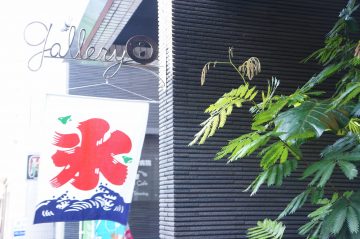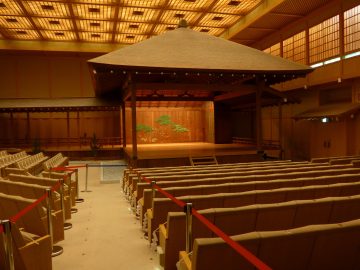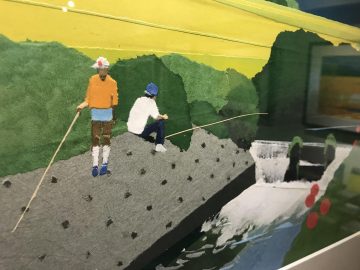Nissan Art Award 2015 | Interview with Yuko Mouri

Published on 2015.12.19 Interview & Text: Taisuke Shimanuki Photo (Portrait): Masamasa Nishino
The Nissan Art Award is an award for contemporary art. The winner of its second Grand Prix was announced the other day. The winner is Yuko Mohri. Known for her style of arranging mechanical everyday items in a space and weaving a network of inorganic matter using light, sound, and magnetism, she is a notable artist who has expanded her field of activity in recent years. We had the opportunity to interview her the day after she won the Grand Prix. What does it mean for an artist to create a work of art, and what is the significance of an award that honors it? We bring you the testimony of the artist Yuko Mohri's current state.
Development from fieldwork
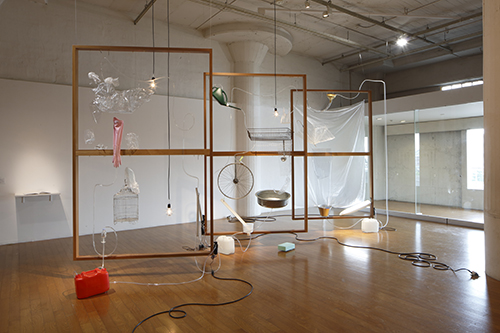
Yuko Mouri, "More More: Given Falling Water #1–3" 2015 / Exhibition view of "Nissan Art Award 2015" / Photo: Keizo Kioku
--Congratulations on winning the Nissan Art Award. First of all, could you give us your thoughts on receiving the award?
Mouri : Thank you. I've been longing for this award since the first one in 2013, so I'm very happy. The work I submitted was a new challenge for me, so I think I would have been satisfied even if I hadn't won the Grand Prix, but I was honored to have been recognized by the judges.
--Could you tell us about your winning work, "MOREMORE: Given Falling Water #1-3"? This work developed from the project "MOREMORE Tokyo," which was a research project on water leak repair sites in subway stations in Tokyo.
Mohri : Of course, I had the idea of submitting something stronger and larger, by further developing the works that I submitted to the Sapporo International Art Festival and Yokohama Triennale in 2014, which have loose relationships within the exhibition space. However, this award is a stage where new works compete with each other, and it is not an exhibition with a central curation like a museum exhibition, so I thought I would take this opportunity to challenge myself to do something I had never done before. So I decided to develop the direction of "More More Tokyo," which I have been doing fieldwork for since 2009.
--Yesterday, during the press tour before the award ceremony, you explained your work by referring to bricolage, a concept and methodology described by social anthropologist Claude Lévi-Strauss. This is a concept and methodology that refers to the temporary creation or repair of tools by collecting scraps and leftover materials, and is in contrast to, for example, a professional craftsman creating a product based on a pre-determined design plan.
Mohri : As I continued researching "More More Tokyo," I discovered a bricolage-like creative method in the way that many station staff deal with water leaks. Some stations are crudely made, while others have a sense of aesthetic consciousness in their materials and shapes. They may not think of it as a "work," but I have always thought that it is undoubtedly a "work." Another big opportunity was the workshop I held at Asahi Art Square in January this year ("More More Tokyo - Making More More in the Kitchen and Toilet"). I deliberately created an artificial water leak in the toilet and kitchen of the venue, and had the participants deal with it. Rather than correcting the cause of the leak, I set the goal to use plastic and buckets to control the path of the water and provide first aid to prevent the surrounding area from getting wet. Then, in about two hours, a truly wonderful "work" was created. I was impressed by the unintentional creativity that was demonstrated when faced with an emergency situation.

Photo on the left | From "More More Tokyo"
Photo on the right | "Moremore Tokyo - Making Moremore in the Kitchen and Toilet" / Venue: Asahi Art Square / Photo: Maezawa Hideto
--Did you sublimate your research and workshop experiences into your work this time?
Mouri : That's right. Because I had those two references, even though it was a new challenge, I was already confident about the direction of the work.
--But I heard that things were pretty chaotic on set during production.
Mouri : This time, for my creation, I first created a water leaking state and then proceeded with the production in a way that dealt with it, but the water leaked so much that the floor of the venue became a mess! The other finalists brought in works that they had already created in the studio and were adjusting the installation and video projection, but next to them, I was just trying to deal with the water leaks every day, and no matter how much time passed, there was no sign of a work at all (laughs). I had set a goal of keeping the wooden frame and floor from getting wet, but I was nervous about whether I would really be able to finish in time for the exhibition opening. I was pouring water over my head and it was almost like a comedy skit from the Drifters.
--Ah, like a basin falling from above. (Laughs) It seems to be so delicately balanced that even a child's slight touch would cause the water to leak out.
Mouri : In fact, it is made up of an extremely delicate balance. For example, the part of the bicycle wheel that rotates like a deer scare is made up of a 2-gram weight that I bought at a fishing tackle shop. It's rotating steadily now, but it was one of the parts that continued to leak until the end. In addition, I usually hang things with fishing line, but fishing line has the property of gradually stretching when it comes into contact with water, so this time I used fishing line. This work would not have been possible without fishing equipment (laughs).
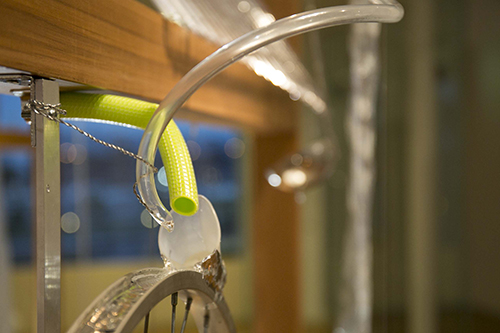
Yuko Mouri's "More More: Given Falling Water #1–3"
The meaning of creating art as an artist
--At the award ceremony, the chairman of the judging panel, Nanjo Fumio, gave a brief commentary, but could you please explain in more detail the reasons for awarding the award?
Mohri : I think the big reason for this was the leap from my previous works. Some of the judges had actually seen my previous works, and they had expected me to present an advanced version of my work, such as "Urban Mining," which used street lamps, or "I/O - A Composer's Room," which used belongings inherited from musicians, but instead I submitted a work in a completely different direction. Also, I think it was because I linked the references to creations that I had found by chance around me to art history in an easy-to-understand way.
--As is clear from the title and the design of the work, it also features a notable quotation from Marcel Duchamp, who is said to be the father of contemporary art.
Mohri : "MOREMORE Tokyo" is a research project on the creations of people who are not artists, but in contrast, the question "What is the meaning of me, an artist, creating a work?" emerged. The water leak repair project we covered in "MOREMORE Tokyo" will be removed once the leak has stopped, and is a sculpture that disappears when its purpose is over, the most instantaneous piece of architecture. However, the works of the finalists of the Nissan Art Award will be collected, maintained, and preserved by Nissan.
--In other words, an artist's job is to create something that will last?
Mohri : I've been thinking recently about how to leave behind my work, which presents not only objects but also the relationships between phenomena such as light and sound as an "ecosystem." "More More Tokyo" will disappear, but as an artist, I may be able to leave something behind. Tino Sehgal, an artist who has others perform guerrilla-like performances in museums and other places, does not allow video or photographic records to be left behind. However, his work is stored as a "work" in Western museums. This means that something that "doesn't exist" is "present." Sehgal's strategy is to leave behind the fact that it "doesn't exist," and even artists who deal with intangible things like him are still thinking about leaving something behind.

Photo on the left: "I/O - A Composer's Room" 2014 / Paper, wood, acrylic, dust, light bulbs, motors, blinds, forks, organs, drums, bells, work boxes, etc. / 294 x 609 x 802 cm (variable)
Venue: Yokohama Museum of Art / Photo: Yuichiro Tanaka / Courtesy: Yokohama Triennale Organizing Committee
Photo on the right: "Underground Circus" 2014 Compass, ammonite, bell, bells, garden furniture, duster, ruler, light, umbrella, fishing line, motor, light bulb / size variable
Venue: Seikatei (Sapporo City Tangible Cultural Property) Chi-Ka-Ho / Photo: Kioku Keizo / Provided by: Creative City Sapporo International Art Festival Executive Committee
--It's true that Duchamp's work Fountain, in which he used a men's toilet, demonstrated that the basis of art is not "creating a substance" but "declaring that this is a work of art." This is said to have expanded the meaning and concept of art.
Mohri : So, this time I gave myself a leak, so I took the title from Duchamp's posthumous work "Suppose (1) Falling Water, (2) Illumination Gas, were Given." Needless to say, readymade items such as plastic bottles, hoses, and buckets are used to deal with the leak. So, I decided to borrow the frame from "Even, the Bride Stripped Naked by Her Bachelors" (commonly known as "The Large Glass") as a homage. In "The Large Glass," the energy of the bride and the bachelors circulates on a flat surface, creating a complex and chaotic circulation. I think "More More Tokyo" is something like that.
--You said in an interview that Duchamp was obsessed with "the idea of movement." Another characteristic of his work is the circulation of wordplay, like a word association game.
Mouri : It seems like the parts were chosen just for the purpose of controlling the flow of water, but in fact there's a lot of waste. I think that's what makes it interesting.
--I think it's amazing how generous Nissan is to house this work. Even though it's a two-dimensional piece, it uses water, and great care must be taken to ensure the circulation is achieved.
Mohri : I think this is the easiest piece to store (laughs). That's because all you have to do is stop the water. I wanted to say that even if the water isn't circulating, it still works as a piece of art. The instructions for managing the piece state that the water can be left running while I'm alive, but that the water should basically be stopped when I die.
--While Mr. Mouri is alive, will he be making the adjustments himself?
Mouri : Yes. If a new leak occurs, we will make it possible to fix it through maintenance.
--But after his death, no changes can be made to him. Does that mean the function of circulating water doesn't have to be maintained forever?
Mouri : It's enough if the result of the bricolage remains in a form. It's enough if it shows the fact that water once flowed and that this kind of design created a path for the water to flow. It symbolizes the circulation of energy.
--That's interesting. The work at the Sapporo International Art Festival referenced a spring called "Memu" that remains in Sapporo. Many of the Memu are now dried up or remain in a different form on the Hokkaido University campus. Although they no longer function, they are passed down as historical relics that convey the modernization of Meiji Japan. What you just said reminds me of that.
Being "passive"
--You started out in the field of media art and then moved to contemporary art. What do you think about this shift in genre?
Mouri : It's not that I'm not conscious of it, but I think the works I create have hardly changed at all. On the other hand, I've had a sense of discomfort with the genre called media art since the beginning. I belonged to Professor Seiko Mikami's seminar at Tama Art University (who passed away in January 2015), and Professor Mikami often asked me the question, "Why do we have a word like media art?"
--Since the 1990s, your works have focused on interactive aspects that use cutting-edge technology. In that sense, you are one of the artists who established the image of media art in Japan.
Mouri : But around 2000, she seemed to have doubts about the name "media art." I remember her saying that she would rather use a term like "media art" or something that puts the emphasis on art.
--In other words, it's not technology-driven.
Mouri : Well, it's true that many of the things that were called "media art" at the time were experiments with "media (technology)" but were unclear as to whether they were "art (expression)". Recently, I've been hearing the term "media art" a lot again, but the meaning may be a little different now than it was then. In any case, I had doubts and concerns about whether it was possible to create without electronic equipment such as computers. That may have been my biggest concern about participating in this exhibition, which is a contemporary art award. For that reason, I have been exploring ways of doing things other than just computer control.
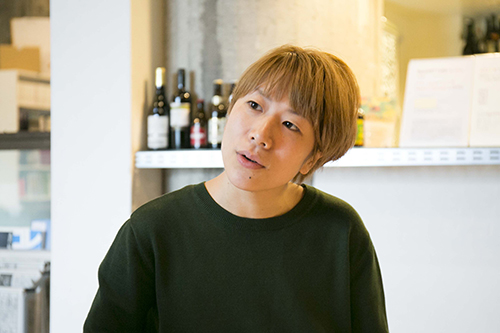
--But now it's common for computers to be used in contemporary art works.
Mouri : That's true. On the other hand, I've always used electronic devices to express myself, but this time I'm finally using only a pump to suck up water (laughs). It may be that computers and vinyl hoses have come to be perceived as being about the same material. However, in the near future, I would like to create a work that uses computers entirely for the first time in a long time. The Internet environment has changed significantly in the last 10 years.
--Even though the use of computers has become commonplace, the invisible programming is the prime example of a black box that mystifies a work. Isn't it important that all the mechanisms of your work are disclosed and that there is no black box?
Mouri : I don't think that will change in the future. Even though you say there is no "black box," it is normal for the mechanism to be difficult to discern due to the characteristics of the medium. For example, this was the first time I used water, and it was very difficult to control the water pressure. Even though I made the water supply and drainage mechanisms visible, there are many parts that make me wonder how the balance is maintained. The other day, a child about 5 years old came to play at the venue and was observing a hose that was constantly twitching. He asked me, "What's going on? How is it doing this?" It was so cute (laughs), but if you look closely, you can see that there is a drain hose attached to the plastic bottle so that water does not accumulate, and that it is circulating from there. But even so, there are still things in the work that evoke a sense of mystery. I think that even if there is no black box, there are just as many mysterious things. The more you show it, the more mysterious it actually becomes.
--You created your new work in this improvisational way, so does that motivate you to continue creating?
Mouri : There are discoveries to be made. Another theme of this work is "passive," which shows that people are creative when they are faced with an unpredictable situation like a water leak. I applied the scenery I saw at the workshop at Asahi Art Square to myself this time...in other words, I forced myself to "impose" it, which is what made this work possible. It was a discovery for me, and it is a strong motivation for me to continue making works in the future.
